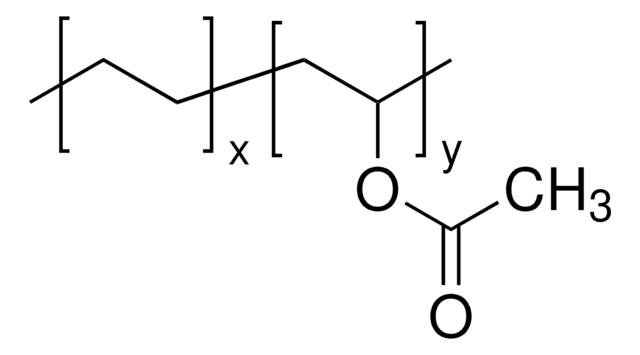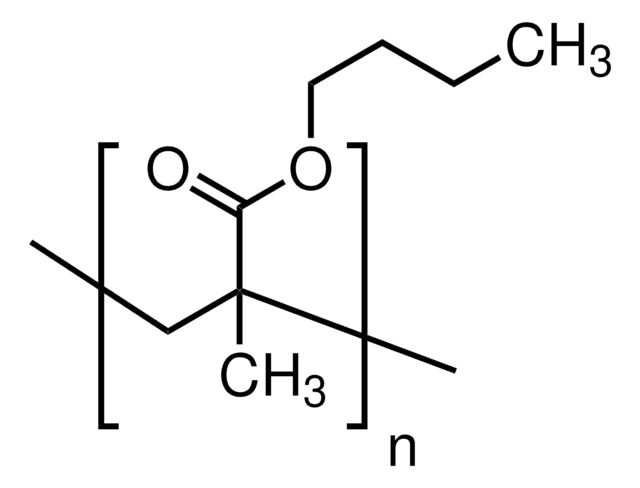340502
Poly(ethylene-co-vinyl acetate)
vinyl acetate 40 wt. %, melt index (41-63 dg/min (190°C/2.16kg)), contains 190-910 ppm inhibitor
Sinonimo/i:
PEVA
About This Item
Prodotti consigliati
Forma fisica
beads
Livello qualitativo
Temp. autoaccensione
500 °F
Indice di fluidità
(41-63 dg/min (190°C/2.16kg))
contiene
190-910 ppm inhibitor
Composizione
vinyl acetate, 40 wt. %
Durezza
40 (Shore A-2, ASTM D 2240)
Temp. transizione
Tg −40-−30 °C
Tm 110-120 °C
Solubilità
toluene, THF, and MEK: soluble
Stringa SMILE
C=C.CC(=O)OC=C
InChI
1S/C4H6O2.C2H4/c1-2-3-4(5)6;1-2/h2H,1,3H2,(H,5,6);1-2H2
DQXBYHZEEUGOBF-UHFFFAOYSA-N
Cerchi prodotti simili? Visita Guida al confronto tra prodotti
Categorie correlate
Descrizione generale
Applicazioni
- Correlation between Cohesive Energy Density, Fractional Free Volume, and Gas Transport Properties: This study explores the properties of EVA materials that affect their gas permeability, important for applications like packaging and barrier materials (Kubica & Wolinska-Grabczyk, 2015).
- The Thermal and Mechanical Properties of EVA and its Crosslinked Analogues: This research investigates how crosslinking affects the thermal and mechanical properties of EVA, which could interest material scientists working with polymers (Wang & Deng, 2019).
- Investigation of morphological, rheological, and mechanical properties of cyclic olefin copolymer/EVA blend films: This study focuses on the blend properties of EVA with other polymers, providing insights useful in academia and material science (Durmus et al., 2018).
- Fabrication, characterization, and properties of EVA/magnetite nanocomposites: Relevant to material scientists, this research discusses the incorporation of magnetite nanoparticles into EVA for enhanced properties (Ramesan, 2014).
Codice della classe di stoccaggio
11 - Combustible Solids
Classe di pericolosità dell'acqua (WGK)
nwg
Punto d’infiammabilità (°F)
Not applicable
Punto d’infiammabilità (°C)
Not applicable
Dispositivi di protezione individuale
Eyeshields, Gloves, type N95 (US)
Scegli una delle versioni più recenti:
Possiedi già questo prodotto?
I documenti relativi ai prodotti acquistati recentemente sono disponibili nell’Archivio dei documenti.
Il team dei nostri ricercatori vanta grande esperienza in tutte le aree della ricerca quali Life Science, scienza dei materiali, sintesi chimica, cromatografia, discipline analitiche, ecc..
Contatta l'Assistenza Tecnica.


![[1R-(2-endo,3-exo)]-3-Hydroxy-4,7,7-trimethylbicyclo[2.2.1]heptane-2-acetic acid 99%](/deepweb/assets/sigmaaldrich/product/structures/302/015/ab0ad101-2636-4430-bd07-e61d744f6817/640/ab0ad101-2636-4430-bd07-e61d744f6817.png)



